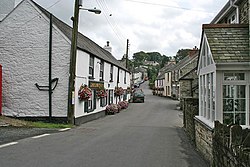Buckland Monachorum
| Buckland Monachorum | |
| Devon | |
|---|---|
 Buckland Abbey | |
| Location | |
| Grid reference: | SX489683 |
| Location: | 50°29’43"N, 4°7’51"W |
| Data | |
| Population: | 1,511 (2006 est.) |
| Local Government | |
| Council: | West Devon |
Buckland Monachorum is a village in western Devon. It stands on the River Tavy northwest of Yelverton, about 10 miles north of Plymouth. The name means "Monks' Buckland", because before the Reformation the manor belonged to the monks of Buckland Abbey.
In 2006 the village had an estimated 1,511 residents and 654 dwellings.
History
Domesday Book of 1086 records Buckland Monachorum (Bocheland) as having land for 15 ploughs, a salt pan and a fishery rendering 10 shillings.[1] The estate was owned by William de Poilley, probably a Norman knight although he is not listed in the rolls of the Battle of Hastings.[2] William de Poilley held 17 estates in southern Devon as a tenant-in-chief of the King, making him a person of local, if not national or regional, significance.
In 1278 a Cistercian abbey was founded at Buckland founded by Amicia, Countess of Devon. It remained the dominant force in the neighbourhood until the Dissolution of the Monasteries by King Henry VIII, when it was sold to Sir Richard Grenville
Buckland Abbey
Buckland Abbey lies to the south of Buckland Monachorum.
Amicia, Countess of Devon, founded the Abbey in 1278. It was a Buckland was a Cistercian abbey and a daughter house of Quarr Abbey, on the Isle of Wight. It became wealthy, as many of the Devonshire houses did.
In 1541, the Abbey was dissolved by King Henry VIII as part of the Dissolution of the Monasteries; the lands were forfeit to the Crown and the monks sent off with pensions. The King sold Buckland Abbey to Sir Richard Grenville who converted it into a grant residence. The conversion was completed by Sir Richard's grandson, also named Richard Grenville, who completed the conversion.
The new Sir Richard Grenville was a naval hero; explorer, coloniser and battle-leader, who took part in the destruction of the Spanish Armada. His death in 1591 at the Battle of Flores, fighting his single ship The Revenge against a Spanish fleet, is celebrated in Tennyson's The Revenge – a Balad of the Fleet.
The abbey is unusual in that the church was retained as the principal component of the new house whilst most of the remainder was demolished, which was a reversal of the normal outcome with this type of redevelopment.
Sir Richard sold Buckland Abbey in 1581 to Sir Francis Drake, a yet more famous naval hero, who bought it out of a portion of the Spanish gold he won during his circumnavigation of the world.
Drake lived in the house for 15 years, and at his death off Puerto Rico in 1596 he left the abbey to his brother, as Sir Francis was childless. It remained in the Drake family until 1946, when it was sold to a local landowner, Arthur Rodd, who presented the property to the National Trust in 1948.
The property has been open to the public since 1951. The National Trust operates it with the assistance of the City of Plymouth Museums and Art Museum use the building to house part of their collection.
The collection is noted for the presence of "Drake's Drum". A number of independent craft workshops are located in the converted ox sheds.
Within the village

The village is the site of St. Andrew's, a 12th-century church with an Anglo-Saxon baptismal font and the tombs of the Drake family and Lord Heathfield, the defender of Gibraltar, many historic buildings, and a complex of interesting gardens, known as "The Garden House". The Gift House, a seventeenth century Almshouse, was built by one of the Drake family.
The Drake Manor Inn, a popular public house, restaurant and B&B - is also situated in the village. A general store and Post Office was situated in the village until 2003. St Andrew's C of E Primary School is located in the village, providing education for around 200 pupils from the local area. In 2007 Ofsted judged the school 'outstanding'.[3]
Nearby villages include:
References
- ↑ Domesday Book, a complete translation. Penguin, London; 2003, p.316
- ↑ http://www.hemyockcastle.co.uk/dev-man.htm
- ↑ http://www.ofsted.gov.uk/filedownloading/?id=841491&type=1&refer=0
Outside links
| ("Wikimedia Commons" has material about Buckland Monachorum) |